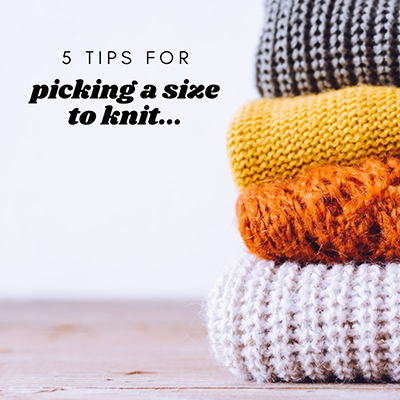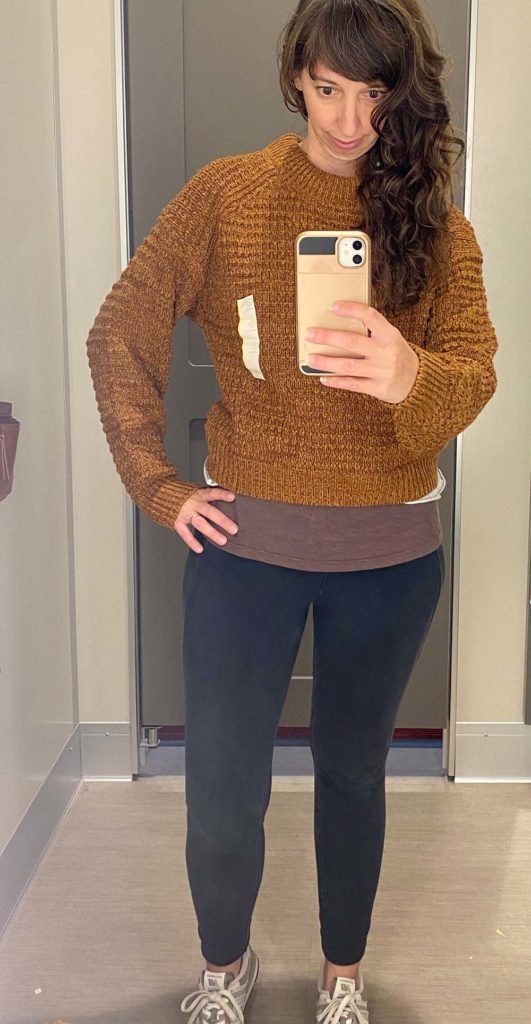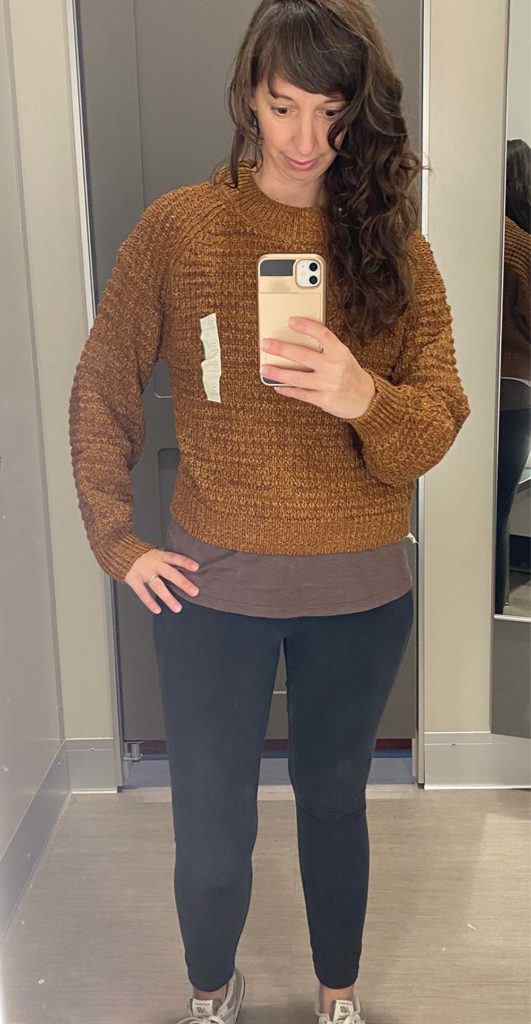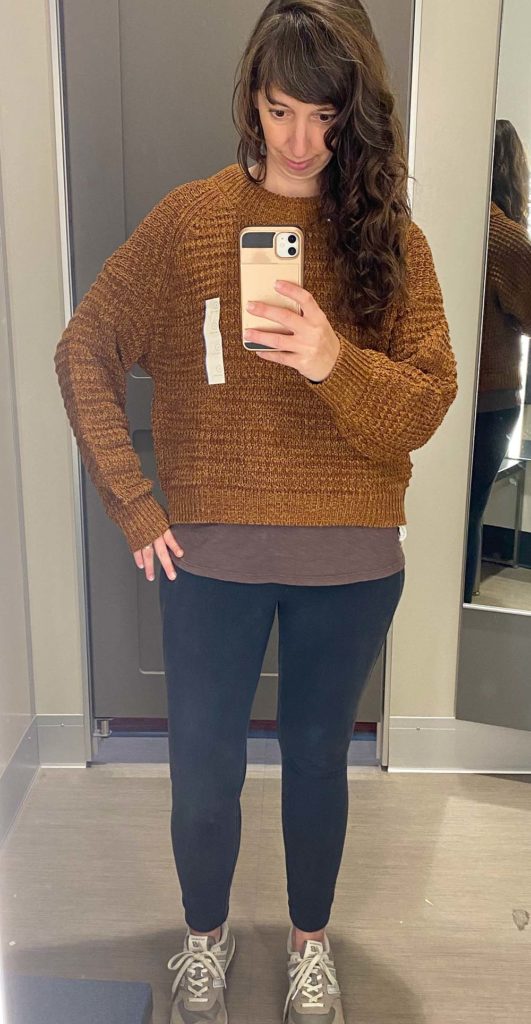When you’re ready to start on a new knitting project, before you even decide on yarn you’re probably thinking the question: “What size should I make?”. For new garment knitters especially, this can be one of the trickiest parts of the project so I thought I’d provide a few tips that I’ve learned through the years. Through trial & error you will find what works best for you, but the 5 tips below will hopefully help guide you a bit!
Tip #1: Check if the designer has provided a suggested amount of ease
In all of my patterns, on the Pattern Information Page, I provide guidelines on the amount of ease I recommend. What is “ease”? Ease is the difference between your actual body measurement and the finished measurement of the garment. So if a pattern suggests 2-4″ of positive ease, that means you should consider picking a size whose finished measurement is 2-4″ larger than your actual body measurement (typically it’s the actual bust or high bust/upper torso – see tip #2 for the difference between these). A designer will suggest a certain amount of ease based on the construction-style of the garment, the type of gauge/yarn used and the overall look they were going with. Often raglan-style sweaters (like my Audrey’s Cardigan or Ramona) will suggest 1-4″ of positive ease whereas a drop-shoulder construction sweater (like my Alanis or Ice Breaker tops) will often suggest a larger amount, typically 6-12″ of positive ease. For more details about what positive ease is all about and why different construction-types call for different amounts of ease, check out my previous blog post here.
Tip #2: Measure yourself (or have a friend or local yarn shop help!)
Understanding your actual body measurements is super helpful information to have handy. So it’s a good habit to regularly measure yourself so you are starting with accurate information. Your actual bust measurement is not your bra size. When measuring your bust, measure around the fullest part of your chest. This is considered your “actual bust”.
Another good measurement to take is called your upper-torso (or sometimes referred to as “high bust” or “upper chest”). This is the circumference around your upper chest, typically measured around your underarm/armpit. For some people, this measurement is more accurate to use as the “base” (instead of your actual bust) because it can be a better indicator of your torso and frame size (especially true if you have a larger bust but smaller shoulder width).
I also recommend measuring all the circumferences on your torso – so your abdomen and hips. Because your bust or upper torso may not be the largest circumference on your torso (it’s not for me – my hips are a good 6″ wider than my actual bust). Depending on the style/cut of the sweater, you may be advised to base the amount of ease not necessarily on your bust but on your widest circumference. Or, you may just want to make sure that you have the recommended amount of ease at your bust, and at least some positive ease at your abdomen and hips. For tips on how to measure yourself, check out this article from Interweave Press.
Tip #3: Think about how you want to wear your garment
In any particular garment design, there can be multiple sizes that will technically fit you. But how you plan on wearing and styling the garment will decide which size might be the best option (this is considered your preferred or desired fit). Is it a pullover or cardigan? What yarn/gauge is it? Do you think you might want to style it over a dress or tunic? Do you envision having enough fabric in the front (for a cardigan style) to be able to close it with a shawl pin, belt or other type of closure? Do you want to wear it with your office dress pants and a more tailored fit or are you thinking a more layered, casual look? Envisioning how you think you may want to wear it will help you to narrow down your options. And this brings me to tip #4…
Tip #4: Learn what your “preferred fit” is by studying your closet
One idea for understanding how you typically wear your sweaters/tops is to study your closet! Even if they aren’t hand-knit garments, measure your tops in your closet and pay attention to not only their width and length but compare that to the cut of the garment as well. Do you notice a pattern where, say, your boxier tops measure wider and shorter than your more fitted ones? Or do you notice that your lighter-weight garments are wider than your heavier-weight ones? These are all things to pay attention to. You may learn that most of the layering tops you love the most all have a width of, say 22″. This helps to tell you that you may want to pick a knitting size whose finished measurement is around 44″ or so.
Tip #5: Try on lots of sizes
Did you ever watch the show “What Not to Wear”? It was a guilty pleasure of mine back in the early 2000’s. One thing I always remember of that show was how they stressed the importance of trying things on. And that you just never know what you might like or the type of fit until you give it a try on your unique body. So if you want to experiment with understanding what type of fit you may look for in your knits, try this tip: next time you go clothing shopping, if there is a garment that looks knit (it will of course be machine knit but that’s ok), grab multiple sizes and head to the dressing room! Try them all on and study how each fits on you and what you like/don’t like. You may be surprised which size you land on! And it will be a great lesson in learning what kind of sizing you prefer for different style garments.
I did this at Target recently to prove my point – I found a sweater that was machine knit and grabbed a S, M and L.
Which size did I land on? My preferred fit was the large. The small would work if I wanted a more fitted look (but I rarely do with sweaters – just a personal preference I have especially with pullovers). The medium would have worked if I wanted a more standard sweater fit and intended to wear it to the office or just a bit more dressed up. But I envisioned wearing this sweater mostly at home, walking my dog, wearing with leggings, etc. So I didn’t want it cinching in too much at my hips and wanted that more relaxed fit. The large gave me all of that.
Here’s another interesting tidbit on this topic – a few years I took a trip to a new consignment store I had never been to and the owner had everything organized not by size or style but by color (it was visually stunning!). When we chatted with her about this approach, she said that she wanted to teach her customers that size is so subjective. In some brands, you may be a size 8 and in another brand you’re a size 12. Or, depending on the cut of the garment and your preferred “look”, you may choose a size that is different than some of your other garments. So by organizing things by color, people gravitated towards the colors they loved and were more open to experimenting with different styles and sizes. Just another thing to think about! On your next shopping trip, perhaps try experimenting with different sizes/cuts/styles – it can all help you better refine what your “preferred fit” may be in your next knitting project.
Don’t be discouraged!
We have all been there – you think you’ve picked the right size to knit but in the end you’re not happy with how your finished garment fits. But if there is any light at the end of this tunnel it’s this: I’ve learned the most from the garments that haven’t fit me. So don’t get discouraged. I know yarn isn’t cheap so an ill-fitting garment can be extremely frustrating, but you can always gift it to someone whom it may fit perfectly on. Or, you can consider re-purposing the yarn (check out my tutorial about that here!).
But before you gift it or re-purpose the yarn, take the time to study the finished garment. What don’t you like about the fit? Did the finished measurement match the schematic and you just didn’t pick the right amount of ease, or did your gauge change as you knit and that’s what caused the problem? Understanding what went wrong will just better inform your next project and help you gain more knowledge about what your desired/preferred fit really is.
I hope some of these tips help you to better refine your ‘picking a size to knit’ process!





